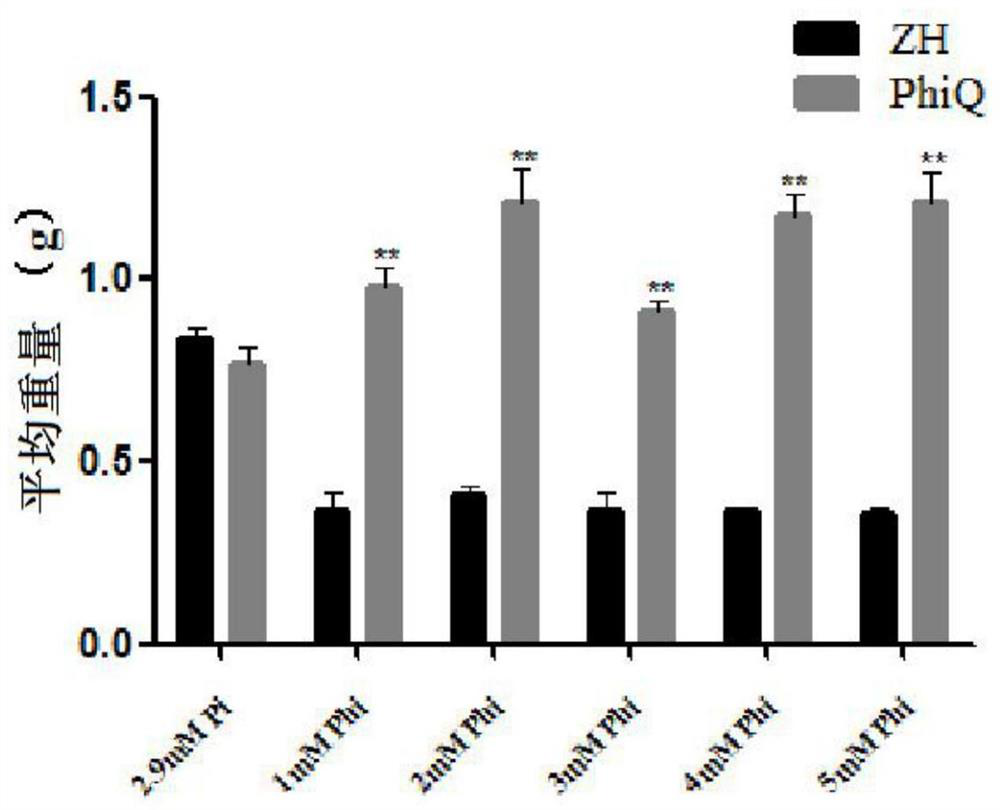Screening method of transgenic rice
A technology of transgenic rice and a screening method, which is applied in the field of efficient and safe genetic transformation and screening of transgenic rice, can solve the problems that the phosphomannose isomerase gene cannot be used as a marker gene of transgenic tobacco, cannot use antibiotics, etc., and achieves rapid identification and screening. The effect of improving efficiency and reducing conversion costs
- Summary
- Abstract
- Description
- Claims
- Application Information
AI Technical Summary
Problems solved by technology
Method used
Image
Examples
Embodiment 1
[0036] Construction of Overexpression Vector of Phosphite Dehydrogenase Gene (PhiQ)
[0037]According to the nucleotide sequence of the PhiQ gene, PCR primers were designed and synthesized to amplify the PtxQ gene. The PCR system and amplification conditions are shown in Table 1.
[0038] The primer sequences are as follows:
[0039] PhiQ-F: 5'-tgcaggtcgactctagagATGAAGCCGAAGGTGGTCCT-3',
[0040] PhiQ-R: 5'-tcgagctcggtacccgggTTAGGCGGCCTTCACGCCTGGGT-3';
[0041] Table 1 PCR reaction system and amplification conditions
[0042]
[0043] The obtained PCR product was subjected to agarose gel electrophoresis, and the PCR product of PhiQ gene was recovered using the gel recovery kit provided by Beijing Kangwei Century Biotechnology Co., Ltd. The pCAMBIA1300-35S plasmid was digested with BamH I, subjected to agarose gel electrophoresis, and then the linearized pCAMBIA1300-35S plasmid was recovered using the gel extraction kit provided by Beijing Kangwei Century Biotechnology Co....
Embodiment 2
[0045] rice genetic transformation
[0046] (1) Test materials The wild-type (ie non-transgenic) rice variety Zhonghua 11 (also known as ZH11, from the Institute of Crop Science, Chinese Academy of Agricultural Sciences).
[0047] (2) Rice transgenic method
[0048] 1) Preparation of rice mature embryo callus
[0049] Remove the husks from the 11 seeds of wild-type rice Zhonghua, pick plump and smooth seeds in a beaker, disinfect them with 75% ethanol solution for 1 min in an ultra-clean workbench, pour off the ethanol, and then use 20% (v / v) NaClO The solution (approximately 1-1.2% available chlorine) was disinfected for 10 minutes. Pour off the NaClO solution, wash 5-6 times with sterile water, and finally soak in sterile water for 30 minutes, pour off the sterile water, and dry the seeds on absorbent filter paper. After drying, the seeds were transferred to the induction rice medium (Table 6) with tweezers, and placed in a dark incubator at 28°C for 28-30 days. Then ope...
Embodiment 3
[0086] Comparison of Survival Rates of Wild-type and Transgenic Rice Callus Under Phosphite Treatment
[0087] Select the wild-type ZH11 and transgenic PhiQ rice calli with basically the same growth status, size and color, and put them on the rice subculture medium with five phosphite treatment concentrations of 1-5mM, and at the same time, use the normal phosphate concentration of 2.9mM as the experiment As a control, culture was carried out in a dark incubator at 28°C. After 14 days of culture, the phenotypes of wild-type ZH11 and transgenic PhiQ rice callus were observed and compared, and the survival rates of wild-type ZH11 and transgenic PhiQ rice callus were compared.
[0088] Depend on figure 1 It can be seen that on the rice subculture medium containing phosphite as the only phosphorus source, the growth of wild-type ZH11 rice callus was significantly inhibited, and the survival rate was significantly reduced compared with normal phosphate treatment conditions; while ...
PUM
 Login to View More
Login to View More Abstract
Description
Claims
Application Information
 Login to View More
Login to View More - R&D
- Intellectual Property
- Life Sciences
- Materials
- Tech Scout
- Unparalleled Data Quality
- Higher Quality Content
- 60% Fewer Hallucinations
Browse by: Latest US Patents, China's latest patents, Technical Efficacy Thesaurus, Application Domain, Technology Topic, Popular Technical Reports.
© 2025 PatSnap. All rights reserved.Legal|Privacy policy|Modern Slavery Act Transparency Statement|Sitemap|About US| Contact US: help@patsnap.com



